Open Space Strategies and Play Sufficiency Assessments Regulations: consultation
This consultation paper discusses proposed provisions and seeks views on both sets of draft regulations on Open Space Strategies and Play Sufficiency Assessments.
Open Space Strategies
Benefits of Open Space, Green Infrastructure, and Green Networks
9. Our guidance Green Infrastructure: Design & Placemaking[7] sets out the benefits of green infrastructure.
Placemaking
- reinforcing local landscape character
- making places more beautiful, interesting and distinctive
- giving places character and a strong identity
Economic
- improving the image of a place
- helping developers get the most out of the site by combining uses, e.g. open space + SUDS, helping development viability
- attracting businesses and inward investors by creating attractive settings
- making it cheaper and easier to deal with surface water by keeping it on the surface
- saving energy and money for residents and end users
Climate change
- reducing CO² emissions by providing non-vehicular travel routes encouraging walking and cycling
- providing carbon storage and sequestration in vegetation
- providing shelter and protection from extreme weather
- managing flood risk: living roofs, large trees and soft landscape areas absorb heavy rainfall
- providing for storage of surface water in times of peak flow in SUDS and other water features
- cleaning and cooling the air, water and soil, countering the 'heat island' effect of urban areas
- saving energy: through using natural rather than engineered solutions
- saving energy: living roofs insulate buildings, and large trees provide shade, reducing the need for air conditioning in the summer and raising ambient temperatures in the winter, reduction in heating costs in the winter due to slowing of wind speeds in urban areas
Environmental
- reducing pollution through use of SUDS and buffer strips
- providing new and linking existing habitats or natural features, to allow species movement
- protecting aquatic species through appropriate management of waterside habitats
- preventing fragmentation of habitats
- allowing diverse habitats to be created which are rich in flora and fauna
Community and social
- creating green spaces for socialising, interaction and events
- more opportunities and places for children to play
- providing improved physical connections through green networks to get between places; and to communities, services, friends and family and wider green spaces
- providing spaces for practising and promoting horticultural skills
- creating opportunities for community participation and volunteering
Health and Well-being
- encouraging exercise and physical activity by providing quality green spaces for walking, cycling, sports and play
- providing better opportunities for active travel and physical activity
- improving mental well-being by providing access to nature and attractive green spaces and breathing spaces
- providing opportunities for growing food locally and healthy eating
Link to National Planning Framework 4 (NPF4)
10. The draft NPF4[8] sets out a placemaking approach to considering the provision and protection of blue green infrastructure, which covers open space and green networks. Blue and green infrastructure is reflected within the wider universal policy on design, quality and place, and the six qualities of successful places.
"We want our places to be greener, healthier, and more resilient to climate change by supporting and enhancing blue and green infrastructure and providing good quality local opportunities for play and sport.
Networks of blue and green infrastructure are an integral part of successful places. Blue and green infrastructure (such as green spaces, sustainable urban drainage systems, urban trees and green roofs and walls) can offer a wide range of benefits. They can support lifelong health and wellbeing, climate resilience, flood risk management, temperature regulation in urban areas, reduction of air and noise pollution, biodiversity and nature networks, while also supporting good, green jobs.
Accessible, high quality natural and civic spaces can be used by communities for many activities: exercise and recreation, play, sport and connecting with nature." (Draft NPF4)
Purpose
11. Section 3G (2) of the Act states "an open space strategy is to set out a strategic framework of the planning authority's policies and proposals as to the development, maintenance and use of green infrastructure in their district, including open spaces and green networks."
12. As such, open space strategies should provide an effective, corporate means of coordinating the policies of the different council departments with responsibilities for 'development, maintenance and use' of green infrastructure including planning, regeneration, estates / property, parks, land services, environment, play, flooding, and active travel.
13. Section 3G (3) sets out an open space strategy must contain:
(a) an audit of existing open space provision,
(b) an assessment of current and future requirements, and
(c) any other matter which the planning authority consider appropriate.
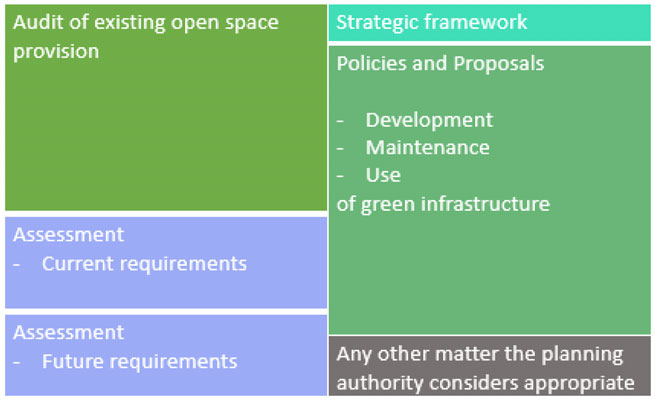
Graphic text below:
Audit of existing open space provision
Assessment - Current requirements
Assessment - Future requirements
Strategic framework
Polices and Proposals
- Development
- Maintenence
- Use of green infrastructure
Any other matter the planning authority considers appropriate
Outcomes based approach
14. Through the OSSPSA Working Group, stakeholders proposed that the regulations should ensure authorities take an outcomes based approach for their open space strategies.
What is an "Outcomes-Based Approach"?
An outcomes-based approach means focusing on what the policy should achieve, rather than inputs and outputs, it encourages organisations to work across traditional boundaries, looking at the bigger picture. It is positive and forward-looking, thinking about what type of places we want in the future, and what they can help achieve.
15. In developing the proposed outcomes in the Draft OSS Regulations we considered other sets of existing outcomes/goals/approaches including:
- UN Sustainable Development Goals;
- the National Performance Framework's national outcomes and the national indicator on access to green and blue space;
- the 6 Outcomes for the National Planning Framework prescribed in the Planning Act; and
- other planning policy principles.
16. We also considered equality data on access to quality open space (more details are set out in the accompanying Equalities Impact Assessment (EQIA)). The evidence reveals there are inequalities in access to quality open space:
- there is a marked difference by ethnicity in terms of living within a five 5 minute walk of the nearest greenspace, with just 45% of ethnic minorities reporting living within a 5 min walk, compared to 66% of those from the white ethnic group.
- people living in the most deprived areas are less likely, than people in less deprived areas, to live within a 5 minute walk of their nearest greenspace.
- access to outdoor space at home varies by tenure, with homeowners more likely to have access to private gardens.
- respondents living in the 15% most deprived areas of Scotland were more likely to agree or agree strongly that the quality of their local greenspace has reduced in the past 5 years.
- women and girls are likely to have greater concerns about their personal safety travelling to / from and within parks and green spaces. Evidence shows that women are under-represented in their use of green space, proportionate to their numbers in society, and that women's use of urban green space may be influenced by the quality of the green space, and feeling safe, to a greater degree than men's.
- fewer people with a limiting long term health condition responded that they live within 5 minutes' walk of their nearest green or blue space compared to those without such a health condition. Evidence also reveals barriers to disabled people's use and enjoyment of parks and greenspaces.
- Christians or those having no religion were significantly more likely to live within 5 minutes of a greenspace compared to those belonging to another religion (63% of Christians, compared to 48% of those from other religions).
17. This has led to the development of 6 proposed outcomes which have been discussed with stakeholders, as set out in draft Regulation 3(2):
(a) improving access to green infrastructure, open space and green networks,
(b) creating successful and sustainable places,
(c) improving health and wellbeing,
(d) advancing equality and eliminating discrimination,
(e) securing positive effects for biodiversity, and
(f) mitigation of and adaptation to climate change.[9]

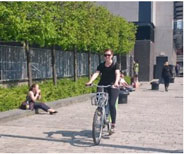
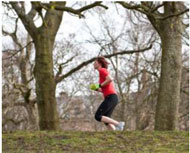

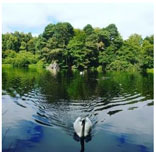
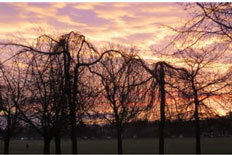
18. We see the proposed outcomes as a series of principles to inform planning authorities' approach in carrying out the OSS to secure multiple benefits, rather than something they would be assessed against. To that effect, draft Regulation 3(1) requires planning authorities, in preparing their OSS, to take into consideration how the policies in the strategy contribute to the outcomes, and linked to that draft Regulation 3(3), requires planning authorities to include a statement about how their OSS contributes to the outcomes.
19. To support authorities taking a structured approach in considering the outcomes, we may explore how guidance on carrying out audits, and assessing quality, could be linked to the outcomes.
Consultation Question 1
a) Do you agree with the idea of promoting an outcomes-based approach through the OSS Regulations? Yes/No/No View. Any Comments
b) Do you agree with the suggested outcomes? Yes/No/No View. Any Comments
Scope of Open Space Strategies
20. The Act says that open space strategies are to cover green infrastructure in the planning authority's district, including open spaces and green networks.
Definitions
21. The Act provides definitions of 'green infrastructure', 'open space' and 'green networks', however some of those definitions differed from those included in Scottish Planning Policy. During the course of the Planning Bill an amendment was added to give Ministers the power, to add, amend, or delete any of these definitions.
22. We considered the definitions against various existing definitions from Scottish, UK and international organisations, including definitions from Scottish Planning Policy and considered work on definitions carried out by Glasgow Clyde Valley Green Network Partnership along with Northumbria University. Discussions were held with a sub-group, including representatives from NatureScot, Glasgow Clyde Valley Green Network Partnership and Northumbria University, and with planning authorities and the OSSPSA Working Group on the definitions. Following these discussions we propose in draft Regulation 2, amending the Act's definitions and adding definitions of 'green space' and 'ecosystem services'. The proposed amendments to section 3G(4) of the Act would see the terms defined as follows:
"open space" means space within and on the edge of settlements comprising green space or civic areas such as squares, market places and other paved or hard landscaped areas with a civic function.
"green space" means space which provides a recreational function, an amenity function, or aesthetic value to the public such as areas of -
(a) grass,
(b) trees,
(c) other vegetation,
(d) water,
but not including agricultural or horticultural land."
"green infrastructure" means features or spaces within the natural and built environments that provide a range of ecosystem services.
"green networks" means connected areas of green infrastructure and open space, that together form an integrated and multi-functional network.
"ecosystem services" means the benefits people obtain from ecosystems.
Consultation Question 2
Do you agree with the proposed definition of
a) 'open space' Yes/No/No View/ Any Comments
b) 'green space' Yes/No/No View/ Any Comments
c) 'green infrastructure' Yes/No/No View/ Any Comments
d) 'green networks' Yes/No/No View/ Any Comments
e) 'ecosystem services' Yes/No/No View/ Any Comments
Open Space Audit
– size threshold
23. The Act requires the OSS to contain an audit of existing open space provision. To provide a degree of consistency and avoid it being too onerous for planning authorities we think it would be useful to set a size threshold in the Regulations, as to the minimum size of spaces that have to be included in the audit. Draft Regulation 4(2) sets out that authorities must audit all open spaces in their area that are 0.2 hectares or greater, and any other smaller spaces that the planning authority considers appropriate to include.
24. The 0.2 ha threshold is proposed as that level is already used in many existing open space audits as well as the Development Management Procedure (Scotland) Regulations 2013 [10] (in defining Outdoor Sports Facilities). We also recognise there may be smaller spaces that authorities may wish to include, and so flexibility has been provided to allow these to also be included should the authority wish. This could be where a smaller space is recognised as being of particular value to the community, or makes a significant contribution to particular outcomes e.g. for flood water management purposes or habitat connection purposes, or where the authority has included it in previous audits and wishes the data to continue from its baseline.
25. It is worth emphasising the 0.2 ha threshold relates to 'open space', which is defined as being spaces 'within and on the edge of settlements' (see paragraph 22 on Definitions). We hope this will be helpful to rural and island authorities, by focussing the audit on the spaces that are most valued and accessible to communities.
Consultation Question 3
Do you agree with proposed thresholds for open space audits in Draft Regulation 4(2)?
Yes/No/No View/ Any comments
– data collection
26. Existing guidance in 'Planning and Open Space' PAN 65 set out essential aspects to cover in an open space audit.
"The essential elements of an audit are to record the type, functions, size, condition, location and maintenance requirements of the spaces and to provide some insight on levels of use. The process should also identify community views on the value of open spaces and aspirations for their future role. It may sometimes be useful to record details such as ownership or any history of flooding. Qualitative indicators, for example ranking quality and condition of facilities, can help to establish fitness for purpose." (PAN 65 (para 24)
27. Draft Regulation 4(3) requires audits to, for each open space included in the audit, provide, information on its -
- location,
- size (in hectares), and
- type
and Draft Regulation 4(4) requires that this is presented using GIS based digital mapping.
28. Location and size – these pieces of information are vital to see the levels of provision, and consider quantity and accessibility. Digital mapping systems (Geographic Information Systems) can show this information, which is available as part of the Ordnance Survey Greenspace dataset.
29. Type – we are also proposing open spaces should to be categorised by type. Information about the existing provision of different types of open space, can help in planning to ensure there is a mix of different types of spaces within an area to suit people's different interests and to help in fulfilling different purposes, linked to the outcomes.
30. PAN 65 sets out a typology of open space types. Planning authorities are accustomed to using the PAN 65 types and providing information, identifying the type of open spaces in their area, as evidenced by the inclusion of type data in authorities previous and current non-statutory open space audits.
31. This typology was expanded as part of the development of the methodology for Scotland's Greenspace Map, which is now used by Ordnance Survey in the Greenspace Map. Ordnance Survey provides detailed data on types for much of the country (settlements of 500 population or more[11]).
32. At one of the OSSPSA Working Group workshops it was suggested it would be helpful to look to merge the PAN 65 and Ordnance Survey's list of types. We are not intending to specify the list of types in the regulations themselves, but to set them out in guidance. We carried out a comparison exercise that builds on, and updates the PAN 65 types, reflecting the data that is available through Ordnance Survey. The proposed set of types, we intend to cover in guidance, covers the full spectrum of 'green', 'blue' and 'grey' spaces - including green spaces, blue spaces (linked to water), and grey spaces (man-made civic spaces).
Type |
Description from PAN 65 |
Sub-types |
|---|---|---|
Public parks and gardens |
Areas of land normally enclosed, designed, constructed, managed and maintained as a public park or garden. These may be owned or managed by community groups. |
|
Playspace for children and teenagers |
Areas providing safe and accessible opportunities for children's play, usually linked to housing areas. |
Playspace for children and young people |
Private gardens or grounds |
Areas of land normally enclosed and associated with a house or institution and reserved for private use. |
Private gardens School grounds Institutional grounds |
Amenity greenspace |
Landscaped areas providing visual amenity or separating different buildings or land uses for environmental, visual or safety reasons and used for a variety of informal or social activities such as sunbathing, picnics or for a kick-about. |
Amenity - residential or business Amenity - transport |
Sports areas |
Large and generally flat areas of grassland or specially designed surfaces, used primarily for designated sports (including playing fields, golf courses, tennis courts and bowling greens) and which are generally bookable. |
Playing fields Golf courses Tennis courts Bowling greens Other sports |
Green corridors |
Routes including canals, river corridors and old railway lines, linking different areas within a town or city as part of a designated and managed network and used for walking, cycling or horse riding, or linking towns and cities to their surrounding countryside or country parks. These may link green spaces together. |
Green access routes Riparian routes Canals |
Natural/semi-natural greenspaces |
Areas of undeveloped or previously developed land with residual natural habitats or which have been planted or colonised by vegetation and wildlife, including woodland and wetland areas. |
Woodland Open semi-natural Inland water Beaches & foreshores |
Allotments and community growing spaces |
Areas of land for growing fruit, vegetables and other plants, either in individual allotments or as a community activity. |
Allotments Community growing spaces (including community gardens and community orchards) |
Civic space |
Squares, streets and waterfront promenades, predominantly of hard landscaping that provide a focus for pedestrian activity and can make connections for people and for wildlife. |
Squares Market places Manmade surface - other paved or hard landscaped areas with a civic function |
Burial grounds |
Includes churchyards and cemeteries. |
Religious grounds Cemetery |
Other functional greenspace |
May be one or more types as required by local circumstances or priorities. |
Camping or caravan park |
33. By considering 'type' which may include natural / semi-natural greenspaces and woodland there is scope for planning authorities to make links between their Open Space Strategy and Forestry and Woodland Strategy (which are also now requirements of the Planning Act).
34. Other information – draft Regulation 4(5) sets out other aspects that planning authorities may include information on:
- accessibility to the public;
- functions of open spaces;
- the extent to which open spaces deliver those functions;
- presence of play opportunities; and
- condition.
This was drafted to reflect advice in PAN 65, reflecting established practice. It provides some flexibility for planning authorities, as to whether or not they provide information on these aspects; or prioritise it for particular types of open space.
35. Accessibility – we intend to cover in guidance aspects that planning authorities may wish to consider in relation to accessibility. This could cover aspects such as whether the space is well located within the neighbourhood, details of entry points, paths and their quality, transport links (where appropriate), and any barriers that could prevent ease of access and movement whether generally, or by specific groups including disabled people.
36. Functions – open spaces may offer different functions such as supporting health and well-being, whether keeping active or a quiet space, supporting active travel, flood prevention, aesthetic value, or for biodiversity. Planning authorities may wish to define functions in different ways, and so we are not intending to set out a prescribed list of functions. Guidance may offer further details about different functions of open spaces, and how these could support achieving the outcomes.
37. Extent to which the open spaces delivers those functions – this is essentially about whether the spaces are fit for purpose and in relation to quality. This recognises that the criteria to assess the quality of different types of open spaces eg play parks, compared to amenity space, sports areas, or market places could be quite different, and so it is about looking at how well the spaces delivers for its own particular functions.
38. Play opportunities – our discussions with stakeholders have indicated that all of PAN 65's types of open spaces, could, depending on circumstances, offer opportunities for play. To help join up the open space audit and play sufficiency assessment we are suggesting that through the open space audit planning authorities should look at the presence of play opportunities in their open spaces. Guidance may provide more details about play opportunities and playability, and the sorts of things planning authorities might take into account when considering how play-friendly an open space is (see paragraphs 86-90 under Play Sufficiency Assessments).
39. Condition – details about the standard of condition can provide a key insight around the current quality of the space, and can help in re-appraising operational management practice and assessing need for additional/reduction to mowing, litter collection, shrub management, any equipment refurbishment, lighting, etc.
40. We intend to explore in future guidance good practice around stewardship. Where appropriate, planning authorities may wish to provide details of any maintenance programme, and identify who is involved in looking after the space whether the Council, residents groups, 'Friends Of', or other community groups.
Consultation Question 4
a) Do you agree with suggested information to include about each open space (location, size and type)? Yes / No / No View/ Any Comments
b) Do you agree with Regulation 4(5) on the other information planning authorities may include in the audit? Yes / No / No View/ Any Comments
– place-based information
41. As part of a place based approach, we believe that as well as the data on individual open spaces, it will be helpful for open space audits to provide information about the overall local authority area and at a locality scale, which is at a more neighbourhood level.
What are "Localities"?
Localities are
- electoral wards or
- areas the Council defines that are no greater than 30,000 population.
42. Draft Regulation 4(6) requires that audits include statements covering the accessibility, quality and quantity for the totality of open spaces and green networks in their area. This is intended to provide a high level picture as to the state of open space in each local authority area.
43. Similarly, draft Regulation 4(7) sets out open space audits are to include a statement, for each locality within their area, describing the open spaces and green networks in that locality's quality, quantity and accessibility. We believe this localised approach will help support 20 minute neighbourhoods and feed through into place-based local development plans. Some authorities are already doing this in their open space audits, providing settlement statements or accounts.
44. We recognise that the appropriate neighbourhood basis is likely to vary from one planning authority to another and so it should be established locally, by planning authorities. We therefore intend to define in draft Regulation 4(11) that "locality" has the meaning given under section 9(2) of the Community Empowerment (Scotland) Act 2015. This is electoral wards or areas the Council defines that are no greater than 30,000 population – this would provide planning authorities with flexibility when defining localities to match these to their own established localities, which they may already use for community planning.
45. From the evidence in the Interim EQIA we are aware that people from different backgrounds, different groups, and living in different areas may experience different levels of quantity, quality and accessibility to open spaces and play spaces. Requiring planning authorities to consider the 'quantity', 'quality' and 'accessibility' of open space on a locality basis, should help ensure local authorities have information on the amount and quality of open space within local neighbourhoods. This will help authorities to put in place policies and proposals, and to take action to seek to ensure greater equity in access to quality open space.
46. Shared good practice and guidance may offer planning authorities more details about aspects they may wish to include in relation to quantity, quality and accessibility. This may cover points such as:
quantity
- using GIS to provide information on
- overall amount of open space
- splits by open space type
- greenspace per 1000 people
quality
- We intend to work with partners to update guidance in the Greenspace Quality Guide. The update is likely to:
a) focus on the outcomes that quality open space, green space and green networks can support, and how to assess whether spaces are contributing to the outcomes
b) link to the 6 qualities of successful places set out in National Planning Framework 4
c) cover new issues such as playability and climate change which are not in the current guide
d) emphasise the importance of quality in advancing equality and supporting inclusion for different groups including those on low income, women and girls, different race or religious backgrounds, and LGBTQI+.
accessibility
- link to the national indicator on access to green and blue space within 5 mins walk
- getting there,
- the proximity of open spaces to homes
- open spaces' location within neighbourhoods
- spatial / network analysis
- describing any main physical barriers (such as busy roads) or cultural or religious belief barriers that limit access or use by particular groups
- accessibility within the spaces once there, e.g.
- in terms of the path network, places to sit and rest
- the accessibility and inclusiveness of any facilities and equipment provided within spaces
- whether open spaces are accessible to all groups, including disabled people, and feel safe and pleasant
Consultation Question 5
a) Do you agree with suggested approach to require locality level place based information? Yes/No/No View/ Any Comments
b) Do you agree with the three high level aspects that should be covered in these statements 'accessibility', 'quantity' and 'quality'?
Yes/No/No View/ Any Comments
– engagement on the audit
47. We believe meaningful engagement should be an integral part of the audit. Draft Regulation 4(8) requires that in assessing the criteria in draft Regulations 4(5), 4(6) and 4(7) that planning authorities are to seek the views of, and have regard to, any views expressed by:
(a) children and young people, as defined by section 16B(14) of the Act,[12]
(b) older people,
(c) disabled people, as defined by section 16B(14) of the Act,[13]
(d) community councils, established under Part 4 of the Local Government (Scotland) Act 1973,
(e) the public,
(f) key agencies, and
(g) any other person or community body which the planning authority considers to be appropriate.
48. Draft Regulation 4(9) provides that where a planning authority's area (whether in full or partially) falls within the boundary of the Central Scotland Green Network national development, the planning authority are to consult the Green Action Trust. The boundary map is available online.
49. Key agencies are defined in draft Regulation 4(10) as meaning,
(a) Historic Environment Scotland,
(b) NatureScot (meaning Scottish Natural Heritage),
(c) Sportscotland (meaning the Scottish Sports Council),
(d) The Scottish Environment Protection Agency,
(e) Scottish Water,
(f) Public Health Scotland, and
(g) Regional Transport Partnerships (established under section 1 of the Transport (Scotland) Act 2005).
50. This engagement should seek their views and expectations about the existing quality and level of provision of open space, and how well it meets their needs. We are not intending to prescribe how engagement should be done. Planning authorities can use a range of innovative techniques, tailored to local circumstances, to engage with people (including children and young people, residents and users of spaces). Additionally, we intend to explore how digital tools could be developed or promoted to support authorities in carrying out this engagement.
Consultation Question 6
Do you agree with the list of consultees for the open space audit?
Yes/No/No View/ Any Comments
Contact
Email: OSSPSAconsultation@gov.scot
There is a problem
Thanks for your feedback